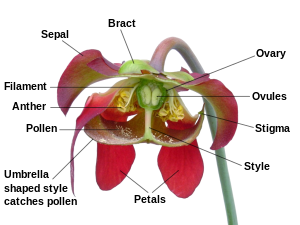Last year I started a website about Texas wildflower, called appropriately Wildflowers of Texas. I would spend as many of my days off as I could, travelling around my local area photographing the wildflowers that I saw. Later I decided to create this blog to compliment the website and allow me to share a little more about the plants, locations and scenery that I observed on my outings. After taking a little break from the blog, I have decided to continue, but at a new location. The Wildflower Blog will now be a part of the main Wildflowers of Texas Website. If you wish to continue following my blog you can find it at Wildflower Blog.
Thank you for reading and I hope you will follow me to the new site.
Jay
Loading
Wednesday, October 17, 2012
Tuesday, March 27, 2012
Pitcher Plants
There are 6 different genera of carnivorous plants with a total of 45 species in the United States. These carnivorous plants can be categorized into 5 basic types, flytraps, bladderworts, butterworts, sundews and pitcher plants. Of these five basic type only the the Venus Flytrap is not found in the Big Thicket of Texas. On a recent trip to a couple of units of the Big Thicket National Preserve I was able to photograph some pitcher plants. The species of pitcher plant that grows in this area is Sarracenia alata, commonly known as Yellow Trumpets or Pale Pitcher. Unlike the other types mentioned pitcher plants are passive since they do not use movement in the capture and digestion of insects. Pitcher plants capture insects by luring them to the mouth of the trap color, nectar, and sent. Once they land on the lip and venture into the mouth, the insects slip on the waxy inner surface. As the insects slide down the funnel they are further impeded by downward pointing hairs lining the lower portion. Eventually ending up in the bottom of the pitcher where they drown in fluid the contains digestive enzymes. The digestive enzymes decompose the body so it can be absorbed, leaving only the exoskeleton.
 |
| Sarracenia alata |
 |
| Looking inside the funnel of Sarracenia alata |
 |
| Immature leaf of Sarracenia alata. |
 |
 |
| Sarracenia flower, cutaway view, with english labels of anatomical parts (Photo credit: Wikipedia) |
Friday, March 23, 2012
Wildflowers of Texas Video
A short video of some of my wildflower photos.
Wednesday, March 21, 2012
Sunday, March 18, 2012
Spring Wildflowers
|
|
| Indian Paintbrushes and Texas Bluebonnets - Bluebonnet Season 2011 (Photo credit: Texas Bluebonnet Sightings) |
Well it's that time of year again. Spring is only a couple of days away and people will be traveling to Texas from all over to view the beautiful display of spring wildflowers. With the drought we have been having the display last year was a bit disappointing. Fortunately we have been having a good bit of rain over much of the state this winter and temperatures have been mild. Hopefully this year will be much improved over last year. Weather you are from Texas or out of state you might want to plan ahead to find out where the best displays are. Here are a few websites to help you plan your trip.
http://www.lone-star.net/wildflowers/sightings.htm
http://www.texasbluebonnetsightings.com/
Sunday, February 26, 2012
Beach Evening Primrose
While doing a little bird watching on McFaddin Beach, I came across this Oenothera drummondii. Beach Evening Primrose is a Texas native perennial, that usually grows in the protected areas behind and between sand dunes. Beach Evening Primrose is a good plant for attracting butterflies.
 |
| Beach Evening Primrose |
Oenothera drummondii was named after Scottish naturalist Thomas Drummond. Drummond came to America to collect specimens in 1830. He arrived in Texas in 1833 and spent 21 months collecting specimens in the state.
Friday, January 13, 2012
Pleasure Island
I made a couple of trips to Pleasure Island, on Sabin Lake to try and photograph a few birds for my Texas Nature Blog and was pleasantly surprised to find a few blooming plants. Here are a few photos of what I founds.
This Bushy Seaside Tansy ( Borrichia frutescens ) was mostly covered with dry seed heads, but a managed to find this one with a couple of boom left.
 |
| Borrichia frutescens - Bushy Seaside Tansy |
 |
| Borrichia frutescens
The Camphor Daisy was fairly plentiful along the south levee.
|
 |
| Rayjacksonia phyllocephala - Camphor Daisy |
Subscribe to:
Comments (Atom)










